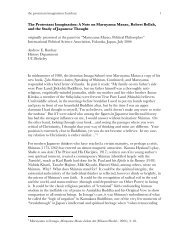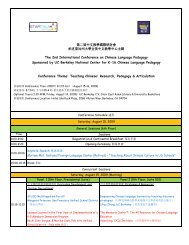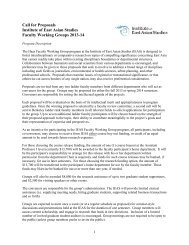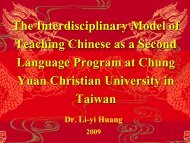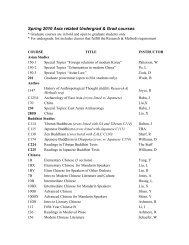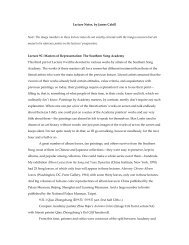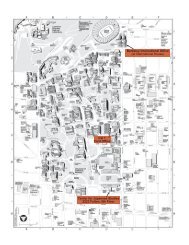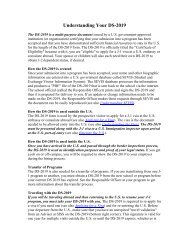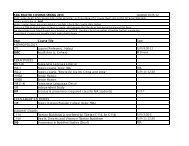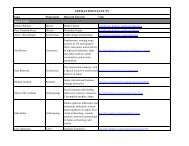Third Edition Spring 2013 - Institute of East Asian Studies, UC ...
Third Edition Spring 2013 - Institute of East Asian Studies, UC ...
Third Edition Spring 2013 - Institute of East Asian Studies, UC ...
You also want an ePaper? Increase the reach of your titles
YUMPU automatically turns print PDFs into web optimized ePapers that Google loves.
a speech in which he referred to Japan as “one nation, one civilization,one language, one culture and one race. There is no othernation (that has such characteristics).” 9 This statement met withsome criticism, but the fact that Aso went on to become prime ministerdemonstrates that his sentiments were by no means rejectedacross Japan at the time.The theme <strong>of</strong> homogeny is part <strong>of</strong> a larger nationalist discoursein Japan in which a distinct Japanese ethnicity is tied tobeliefs about Japan’s past and present orientation to the world. 10To openly acknowledge a heterogeneous Japanese populationthreatens that identity; to openly acknowledge an extant Japanesepopulation pre-dating the so-called ‘ethnic Japanese’ thoroughlyundermines it. Unlike the West, theories <strong>of</strong> evolution in Japanwere not regarded as particularly controversial, something that isrecognized in Japan as a point <strong>of</strong> distinction. 11 Yet, theories <strong>of</strong> theancient settlement <strong>of</strong> the Japanese archipelago are tied to the notion<strong>of</strong> an unchanging ethnicity in which biological and cultural aspects<strong>of</strong> Japanese identity necessarily coincide. 12 The formation <strong>of</strong>Ainu <strong>Studies</strong> in Japan corresponded to the establishment and earlydevelopment <strong>of</strong> anthropology and archeology in Japan, with Ainuserving as a counterpart to other indigenous, ‘uncivilized’ populations,and thus providing the opportunity for Japanese to asserttheir relative superiority by means <strong>of</strong> the ‘race science’ prevalentin the 19th and early 20th centuries.For centuries, Ainu were regarded as an uncivilized ‘other,’and Japanese military campaigns against them may have begunas early as the eighth century; the Nihon Shoki refers to “Emishi,”or barbarians, which is thought to be a possible reference to theancestors <strong>of</strong> contemporary Ainu, though this connection is not es-9 “Aso Says Japan is Nation <strong>of</strong> ‘One Race,” Japan Times, October 18, 2005, 2012,accessed November 1, 2012, http://www.japantimes.co.jp/text/nn20051018a7.html.10 For an overview <strong>of</strong> the relationship between Japanese nationalism and sciencein the nineteenth and twentieth centuries, see: Joan H. Fujimura, “Future Imaginaries:Genome Scientists as Sociocultural Entrepreneurs” in Genetic Nature/Culture: Anthropologyand Science Beyond the Two-Culture Divide, ed. Alan H. Goodman, et al. (Berkeley,CA: University <strong>of</strong> California Press, 2003), 176-199.11 Ibid.12 See: Mark J. Hudson, Ruins <strong>of</strong> Identity: Ethnogenesis in the Japanese Islands(Honolulu: University <strong>of</strong> Hawai’i Press, 1999).tablished. The hierarchy <strong>of</strong> power between notions <strong>of</strong> civilizationversus barbarism was not a concept introduced to Japan by way <strong>of</strong>Western colonialism—it was instead very much a part <strong>of</strong> pre-modernChinese culture. Japan effectively spent centuries acquiringand developing a strong sense <strong>of</strong> what it was to be civilized so asnot to be considered barbaric in the eyes <strong>of</strong> the neighboring Chineseand Korean kingdoms. The later word, “Ezo,” by which Ainuwere called for centuries, is simply a modified pronunciation <strong>of</strong> thesame Chinese characters—‘barbarians.’ However, though regardedas an uncivilized other, Ainu identity did not become racialized asother until the advent <strong>of</strong> ‘race science.’ Western science played a directrole in making race scientific in Meiji and Taisho Japan (1860-1926).Japanese accounts <strong>of</strong> Ainu predate those <strong>of</strong> Western travelers,and Western science was known in Japan since the 18th centuryby way <strong>of</strong> Dutch contact, but it was Western ethnographers inJapan who first unified these approaches and viewed Ainu withinthis scientific framework. 13 The highly contextualized Westerntrope <strong>of</strong> the ‘noble savage’ thus entered Japan, and was received byan audience <strong>of</strong> academics, the first generation <strong>of</strong> Japanese scholarstrained in Western scientific disciplines, who were eager to establisha scientifically-verified Japanese identity. 14 This was a period <strong>of</strong>intense change in Japan, accompanied by the equally intensive formation<strong>of</strong> a nation-state, or nation-civilization, identity. 15 Followingcenturies <strong>of</strong> relative isolation, the selective acquisition <strong>of</strong> Westernculture, including science, was identified as a means <strong>of</strong> gaining aplace at the table with ascendant Western colonial powers (andthereby avoiding a colonized fate). Under the privileged status <strong>of</strong>science, the debate over Ainu origins continued, and a biologicalsupremacy <strong>of</strong> Japanese over Ainu was constructed. Just as in theWest, bodily measurements were sought to “prove” this hierarchy. 1613 Richard Siddle, Race, Resistance and the Ainu <strong>of</strong> Japan. (New York: Routledge,1996), 78.14 Ibid., 81.15 See: “A Point Of View: Making sense <strong>of</strong> China,” BBC News, October 12, 2012,accessed November 1, 2012, http://www.bbc.co.uk/news/magazine-19929620. ThoughJapanese history is strikingly different from Chinese history, the idea <strong>of</strong> civilization-stateas opposed to merely a nation-state is relevant when examining Japanese identity.16 Stepan, “Race and Gender: The Role <strong>of</strong> Analogy in Science,” 368-371. Stepan’s75 Valerie Black Ainu Indigeneity 76




